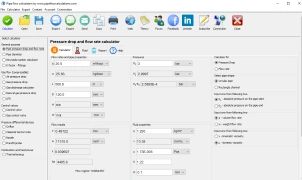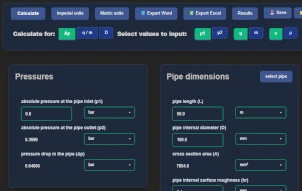When is This Flow Rate Calculator Applicable?
Using a pipe diameter and flow rate calculator makes it easy to determine pipe diameter, flow rate or velocity in the pipe.
Our pipe diameter and flow rate calculator allows quick calculations for closed,
round, and rectangular pipes, filled with liquid or a perfect gas.
If you're analyzing a system with multiple pipes, consider using a
pipe network analysis calculator.
For accurate pipe diameter calculation, you must enter the flow velocity. If flow velocity is unknown,
use the pressure drop calculator
to determine flow rare or pipe diameter based on the pressure difference (head loss)
between the pipeline's start and end.
How Does the Pipe Diameter and Flow Rate Calculator Work?
The pipe diameter calculator determines internal pipe diameter using the fundamental relation between
flow rate, velocity, and cross-sectional area (Q = v·A).
To calculate pipe diameter
- Enter the flow rate and velocity in the calculator.
- Click the calculate button to get results.
To calculate flow rate
- Enter the pipe diameter and velocity in the calculator.
- Click the calculate button to get results.
To calculate flow velocity
Besides pipe diameter, the calculator can also determine:
- Flow velocity for a given flow rate and internal pipe diameter.
- Mass or volume flow rate conversions, using fluid density.
If working with perfect gases, you can convert volume flow rate based on pressure and temperature changes.
This is useful for pipelines with pressure-reducing valves or varying conditions.
For example, if you know the volume flow rate of an ideal gas at standard conditions (p = 101325 Pa, T = 273.15 K), you
can calculate its actual volume flow rate at real pipeline conditions, like p = 30 psi and t = 70°F.
When is the Flow Rate Calculator Not Applicable?
Although highly versatile, some limitations exist:
- If flow velocity and flow rate are both unknown, use a
pressure drop calculator instead.
- For mass flow rate calculations, fluid density must be known. If density is unknown,
mass flow rate calculations are not possible.
- For gases, if pressure, temperature, and density do not follow the ideal gas law,
the calculator cannot determine gas density.
What Information is Needed for Calculations?
- To calculate pipe diameter, you must know flow velocity and flow rate.
If using mass flow rate, fluid density must be known.
- For gas flow, density is derived from gas constant, absolute pressure, and temperature
using the perfect gas equation.
- To calculate flow velocity, the required inputs are flow rate and pipe interior diameter.
How is the Calculation Performed?
The flow rate calculator uses the continuity equation to relate flow rate, flow velocity,
and pipe diameter.
For gas flow, the ideal gas equation determines density based on gas constant, absolute pressure,
and temperature.
This flow rate calculator is an essential tool for engineers and professionals working with liquid and gas pipelines.
Whether determining pipe diameter, flow velocity, or flow rate conversions, it simplifies complex calculations efficiently.







